|
|
The Artists of Fedoskino
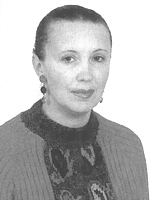 |
Nadezhda
Viktorovna Bychkova was born in Kharkov in 1958.
She graduated from the Faculty of the Decorative Art, Moscow
Technological Institute. Between 1982 and 1988, Bychkova worked
in the Fedoskino Factory of Miniature Painting. A member of
the Union of Russian Artists, Bychkova is residing and working
in Moscow.
In contrast to the majority of artists trained in the Fedoskino
school, Nadezhda Bychkova was educated in the Moscow Technological
Institute. She resides in Moscow, but for many years has been
coming to the factory in Fedoskino. There she met Gennady
Larishev, forming a relationship which has proved of great
importance in her subsequent artistic live.
Nadezhda Bychkova works as an independent miniature painter.
Her works are dominated by folklore and Gospel themes. Nadezhda's
work conveys her ideals and the values important to a woman:
love, maternity and faith. Valentina Smolenskaya recalls the
important role the classes at the Larishev studio played in
her life. She recalls the creative workshops, meetings with
actors and poets, and the viewing of rare films. Because the
artistic development of many of these artists occurred during
Soviet times when art was rigidly managed by the Communist
Party administration, the Larishev studio was instrumental
in expanding the creative horizons of many young artists,
giving them confidence in the value of their work. |
to the top
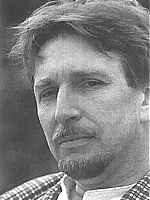 |
Serghei
Ivanovich Kozlov (born 1955) spent his childhood
in the ancient town of Dmitrov near Moscow. His teachers in
the Fedoskino Art School were G.I. Larishev and P.S. Davydov.
Beginning 1976 Kozlov has been working in the Fedoskino Factory.
A member of the Union of Russian Artists and winner of the
National Prize of Russia, Serghei Kozlov is residing and working
in Fedoskino.
Serghei Kozlov is one of the most spectacular artists of
present-day Fedoskino. The quality reflected in his miniatures
is not quiet and thoughtful, but rather lush and solemn, displayed
in the shine of gold and mother-of-pearl. The sun has coloured
the sky with gold, and gold reflects from the surfaces of
the river and sparkles on the snow, as thousands of its rays
are refracted through the misty frost on the branches of the
trees. The fineness of the drawing, the exquisite and composed
palette, and the virtuousity of painting over mother-of-pearl
excite general admiration. The recognizable scenes of the
village environs are rendered symbolically.
A similar approach to imagery can be seen in Kozlov's architectural
landscapes. A black lacquer box with monochromatic scenery
of the Marfino estate — a Gothic castle, pond, elegant
churches — becomes a miniature monument to the culture
of Russian nobility.
The Trinity-St Serghiy Monastery (The Troitse-Serghieva
Lavra) miniature is quite different. The piece is a hymn to
the Russian Orthodox faith, a hymn to architects who created
magnificent architectural monuments, and a hymn to lush baroque
style. The gold of the cupolas is matched by the golden shining
of the skies. The scene is dominated by the figures of three
angels, symbolizing the Holy Trinity.
Of particular importance in works by Kozlov are miniatures
dedicated to Saint Petersburg. Graphic silhouettes of palaces
are featured on several boxes. The black-white drawing of
characteristic conventionality enriched with a silver-blue
hue portrays magnificent buildings and embankments, as well
as sailing vessels gliding over the surface of the Neva River.
The effect recalls engraved 18th century cityscapes of the
young Russian capital.
|
to the top
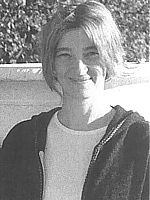 |
Alla Anatolyevna
Kozlova was born in Dmitrov in 1958 into an artist's
family. In the Fedoskino Art School, Kozlova's teacher was
the famous master P.I. Plakhov. She studied miniature painting
in the Fedoskino Art Factory under the guidance of G.I. Larishev
and S.I. Kozlov. Kozlova is a member of the Union of Russian
Artists.
The invariably attractive features of works by Alla Kozlova
are an elegance of drawing, love for the light, tender colouring
and wide use of decorative mother-of-pearl effects. Her miniatures
create the atmosphere of a festival. Her characters are careless
and resemble hilarious dolls, whether the Czar Saltan from
the Golden Cockerel, or young northern beauties listening
to the shepherd's music, or rosy maidens of the 19th century
circling on the ice of the frozen Neva River in the centre
of Saint Petersburg. All these images are a sincere expression
by the artist, reflecting her state of mind as she creates
a hilarious and fanciful performance. |
to the top
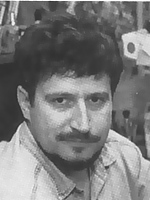 |
Aleksei
Viktorovich Korchagin (born 1960) came to Fedoskino
from the near-Moscow town of Reutovo. His teachers in the
Fedoskino Art School were the artists S.V. Monashov and G.I.
Larishev. A member of the Union of Russian Artists, Korchagin
is residing and working in Fedoskino.
Aleksei Korchagin is engaged in continual creative experiments.
He seems enchanted by the ancient Lukutin articles, by their
beauty and elegance of form, their fine painting and the charm
of their scenes. To this artist, ancient lacquer articles
remain the standard of technical craftsmanship and artistic
taste, for he says he is trying to revive lost methods of
decoration, especially the technique of gilded embossment
In contrast to the old masters of antiquity this artist does
not use gold, but rather works with modern pastes and paints.
He is certain this alteration does not diminish the quality
or integrity of his finished work. Korchagin not only paints
miniatures, but also makes his own papier-mache blanks in
accordance with the design of his work. His studio is stacked
with racks of books and blanks to be used in future creations.
Korchagin portrays a wide range of events: ancient and modern,
pan-human and profoundly personal, funny and tragic The box
Flight to Egypt depicts the Holy Family. Mary, riding a donkey,
is tenderly embracing the Infant. Joseph is walking along,
his face is sad and perhaps reflecting impending doom. He
is dressed as a poor pilgrim, as in the Russian pictures of
the 19th century, and he is wearing boots and carrying a linen
bag over his shoulder and a bundle fixed to a stick The entire
composition, including the browsing donkey, is bound by a
triangle; hence, the movement of the pilgrims is balanced
within the small space of the lid Gold and black lacquer stresses
the sensation of eternity which is the chosen theme, as well
as the theme of family love and concern for the lives of one
other.
The work Art Board is quite different The subject of this
painting is an important event in the life of every artisan
as the process by which artistic works are selected for exhibition.
Portrayed on the top in a grotesque manner are members of
the art board discussing the advantages of a piece of art
placed on an easel. The lateral walls of the box portray two
related events: in one, agitated artists are seen going to
the meeting of the art board, while in the other, after the
unpleasant procedure is over, they are pictured gathering
together to drink a glass of beer and discuss their art problems.
The miniature characters undoubtedly are prototypes of real
life individuals who can be readily identified, including
the artist Korchagin himself, his hair typically pulled back
in a ponytail.
Another important Korchagin work is a miniature inspired
by the famous author Mikhail Bulgakov, titled Master and Margaret.
The novel referred to develops within several eras and conveys
several realities, as illustrated in the paintings. The lateral
sides illustrate the life of Moscovites in the 1930s, including
narrow Moscow streets, a tramway, and comical little people
in baggy clothes hurrying down the street They are painted
monochromatically, in grey-white colours against a blue background,
and resemble shadows. The artist portrays their faces and
movements in grotesque manner, using an air of fantastic exaggeration
similar to the tone of the novel. The string of people and
running dogs seem a peculiar decoration. The box lid features
a mystical scene, including all the evil spirits who appear
in the novel, especially the Cat Begemot, Voland, and Margaret,
all rushing out toward the night sky to behold a shining moon.
Opening the lid, one finds a scene of the crucifixion of Christ
The extended figures of sorrowful people, the light ochre-red
palette, and all the details stress the elevation and significance
of the sacred event. In this way, the artist emphasises the
reality of Christian values and affirms their priority over
vanity and mysticism.
|
to the top
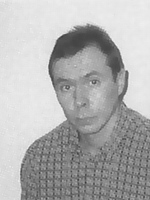 |
German
Gennadyevich Larishev was born in Fedoskino in 1963.
His parents, Gennady Larishev and Margareta Larisheva, were
miniature painters. German's teachers of miniature painting
were S. V. Monashov and G.I. Larishev. German Larishev has
been working in the Fedoskino Factory since 1984. He is a
member of the Union of Russian Artists.
Fedoskino masters are accustomed to handing down their skills
in miniature painting to their children. So is the case with
German Larishev. Gennady Larishev often took his son, German,
along on his painting trips. Together with his father's students,
German, still a young boy, could be found hard at work, patiently
drawing old monasteries and fortress towers. He familiarized
himself with the unique architecture of ancient Russian cities
and this interest later became the main theme of his painting.
The miniatures by German Larishev are a gallery of images
of Russian sights: the Cathedral of the Moscow Kremlin, Saint
Isaac Cathedral in Saint Petersburg, the Sheremetyev Palace
in Ostanldno. Travelling widely, German makes sketches of
architectural monuments and seeks to render them in unexpected
angles and to represent them anew in his miniatures. He is
also attracted by the ingenuous beauty of small towns, as
in these quiet snow-covered streets of Uglich, lined with
old merchant houses.
|
to the top
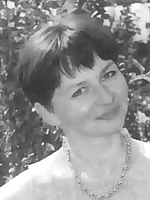 |
Marina
Serafimovna Rogatova was born in the near-Moscow
town of Mytishchi in 1962. Her teachers were S.V. Monashov
and G.I. Larishev. Since 1982 she hasbeen working in the Fedoskino
Factory. A member of the Union of Russian Artists, Rogatova
is residing and working in Kryukoyo.
Kryukovo is home to Serghei and Marina Rogatov. At their
home, Serghei and Marina maintain a garden. All summer long
it is full of the fragrance of the magnificent flowers grown
by Marina. She skillfully adorns the interior of their home
with bouquets of these flowers. Her love of plants is reflected
in much of her artistic output. Floral motifs serve as a basis
for a number of her compositions. She gives particular attention
to rich decor when painting a scene. Following the traditions
of Lukutin artists, she carefully selects an individualized
design for each new idea. Occasionally, however, she must
plan her compositions in reverse, beginning with the shape
or design of the chosen box if it seems to demand a particular
kind of genre or composition. In one case, a mother-of-pearl
chequered inlay suggested to her the theme of chess play,
leading her to paint a handsome cavalier and a lady in fancy
dress deep in thought over a checkerboard.
Another box painting features a card game, and its plot
was inspired by the Pushkin story Queen of Spades. The ominous
Queen of Spades, precursor of misfortunes and symbol of doom,
is in the centre of the miniature. On the right, mingling
with the card kings and queens, is the poet himself, trying
to look into the future by means of cards. The finished box
is covered with exquisite rococo design, reviving the atmosphere
of Saint Petersburg high society and the fashionable salons
of the 19th century.
In her genre miniatures, Marina draws from fantasies about
ancient Russian life, and features fairy tale motifs. The
box Fairy Tales by Alexander Pushkin is shaped like a tower-chamber
and embellished with designs in numerous mother-of-pearl inlays.
On the lid, the miniature painting features The learned Tomcat,
who is telling fairy tales amid the golden branches of the
oak. On the lateral side, Prince Ruslan is viewed in the sky,
fighting the evil wizard Chernomor. And once again, there
is Pushkin, wearing a top hat, holding a cane, and mingling
among his numerous characters, as if watching them.
|
to the top
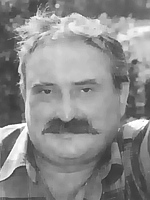 |
Serghei
Sergheyevich Rogatov was born in Fedoskino in 1955
into the family of minature painters. He studied in the Fedoskino
Art School under G.I. Larishev and P.S. Davydov. Since 1974
he has been working in the Fedoskino Factory. He is a member
of the Union of Russian Artists.
Kryukovo is home to Serghei and Marina Rogatov. Serghei Rogatov
is a representative of a large family of Fedoskino artists.
His grandfather worked in a private shop manufacturing figured
trays. His father, Serghei Rogatov, became an artist of the
Fedoskino factory as early as 1939 and, at the age of 80,
still remains at work as one of its oldest craftsmen. Brothers
and nephews of Serghei also work as miniature painters.
Serghei himself sometimes compares the emergence of his
artistic images to the birth of a melody. Just as a tune sounding
in his mind compels him to strum its notes on a guitar, a
new artistic idea prompts him to take up a brush and apply
brushstrokes. On the box My Village Kryukovo, Serghei portrays
the surroundings of his quaint street. It is a winter day.
Standing under an old linden tree are Serghei and Marina.
Their pet dog is lying at their feet. People, animals, birds
and nature abound, and everything is in harmony. The serenity
and silence of this setting, the beauty of their surroundings,
gives rise to many of the images on his other lacquer miniatures.
One of the main themes of Serghei's painting is the fabled
past of his native land. His landscapes feature mysterious
water expanses and ancient Russian boats, and in this featured
painting we see a red bird flying to the sun. The cloud over
the ancient city is pictured as a fearsome dragon. The artist's
favorite images are the hills surrounded by
rivers and lakes, lonely churches on islands, pointed spruce-trees,
and bizarre clouds on a golden sky.
His miniatures reflect other unique qualities. In fact,
it is difficult to interpret Serghei's miniatures unequivocally.
His paintings reflect a conventional world, yet one where
each of the fabled characters faces his or her own unique
fate.
The miniature George the Victor features a peculiar version
of the mythological plot. There is no fearsome dragon, nor
does the night prince appear. A young chap on horseback sees
a snake crawling up toward the houses and kills this source
of impending evil, as if without much thought He does not
appear to regard this act as a "deed." Nor do his
fellow villagers seem impressed by this "miracle":
rather, they appear to be fully engaged in their everyday
affairs. Nevertheless, the artist gives us a poetic image
of a people's defender. The symbolism of the portrayed event
is stressed only through colour. In contrast to the dark colour
surrounding the snake, the remaining scene is enveloped in
golden light, including the background which features golden
scenery and an austere church silhouette.
The miniature After a Promenade pictures amusing figures
of three friends dawdling along a road lined with village
houses. The background is green grass and bright sky. The
people in the scene are reminiscent of the wandering pilgrims
of Russian folk tales. One can imagine that these three chaps,
depicted on Serghei Rogatov's box, are typical of other wandering
pilgrims with the same type of tipsy and good-natured demeanor.
Perhaps, they are on their way from Zhostovo to Kryukovo to
meet other acquaintances in their search for another party. |
to the top
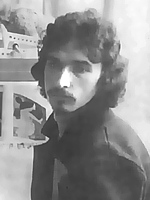 |
Vyacheslav
Alekseyevich Svyatchenkov was born in a near-Moscow
village of Vostryakovo in 1954. His teachers in the Fedoskino
Art School were N.G. Marchukov and G.I. Larishev. Since 1979,
Svyatchenkov has been working in the Fedoskino .Factory. He
is residing in Fedoskino.
The landscapes by Vyacheslav Svyatchenkov are light and transparent.
The artist is striving to convey a tremulous state of nature:
in the dusk, the silhouette of dark trees becomes openwork
against the background of the light sky. The winter forest,
with snow hanging from the branches, reflects a fairy tale
beauty. Miniatures by Svyatchenkov typically show a river
bank with still, unfrozen water, snowy hills, trees touched
with snow ; nd frost, and the serenity and calm of nature.
Outwardly, his landscapes are very simple, yet the artist
expends much time and spiritual force in their creation. The
representation of a landscape on a lacquered article cannot
be compared to a landscape on canvas or to art photography.
The Fedoskino miniature is governed by its own laws, the laws
of decorating a three-dimensional piece. The composition of
the landscape will always be internally bound. A river cannot
flow beyond the scene; the movement of a curved bank is arrested
by hills and shrubs; the rendering of an image is based on
an alternation of planes and is stretched upward. Therefore,
a precise drawing from nature can never be expected on the
surface of a lacquer piece.
Svyatchenkov approaches nature in a unique way. He reports
that he is a fishing addict, and describes the gratification
he experiences when standing for hours in his water boots
waiting for ides — huge fish with golden sides shining
in the sun — to swim up to his feet. In his artistic
work, he seeks to convey a similar shining reflection. He
first makes numerous sketches — perhaps a particular
spruce tree that he has admired, or a bush with bright autumn
colours. All these details become a part of his miniatures.
In the words of this artist, as he describes his composition
process, each landscape is to be completed like a literary
story. |
to the top
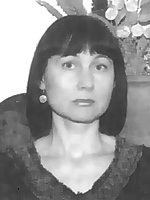 |
Valentina
Konstantinovna Smolenskaya was born in Moscow in
1954. She graduated from the Art Faculty of the Moscow Technological
Institute. Between 1977 and 1983 she worked in the Fedoskino
Factory. Currently, Smolenskaya is a lecturer in the Moscow
State University of Service and a member of the 'Union of
Russian Artists.
In contrast to the majority of artists trained in the Fedoskino
school, Valentina Smolenskaya was educated in the Moscow Technological
Institute. She resides in Moscow, but for many years has been
coming to the factory in Fedoskino. There she met Gennady
Larishev, forming a relationship which has proved of great
importance in her subsequent artistic live.
Valentina Smolenskaya, living in Moscow, feels the difficulty
of being separated from the Fedoskino art world. The patchiness
of the city's artistic life, coupled with the hectic life
of this capital city, seems antithetical to the mood required
for the creation of lacquer miniatures. Hence, she has become
fond of visiting Fedoskino and tries to spend summers there,
observing nature and communicating with artist friends and
colleagues.
Her colourful multi-figured composition Shrovetide Festivities
offers a detailed record of a folk festival. The centre of
the composition is a group of travelling actors. The plot
of the actor's performance is the devil trying to join pious
people for a feast until a guardian angel strikes him with
a spear. Surrounding the stage are a group of spectators,
including aristocrats, merchants and common people. Other
details of this open-air theatrical event include gaffs, an
ice hill, guisers, pie and pancake sellers.
The miniature Glory 1812 was created to commemorate the heroic
events of the Patriotic War against Napoleon. It is difficult
to determine the genre of this work — one finds here
an architectural landscape with the Ivan the Great Bell Tower
in Moscow, a portrait of the field marshal Kutuzov, as well
as the elements of war life. Also present in the artistic
scheme are the use of etching and a popular print conveying
the atmosphere of the epoch. The artist merges all these elements,
creating the effect of a collage in order to convey her overall
theme in an expressive manner. |
to the top
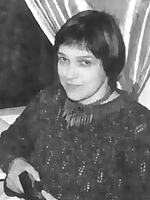 |
Yelena
Yuryevna Khomutinnikova was born in Fedoskino in
1957 into the family of Yu.P. Khomutinnikov, former Director
of the Fedoskino Factory of Miniature Painting. Her teacher
in the Fedoskino School was G.I. Larishev. Since 1978, she
has been working in the Factory. Khomutinnikova is a member
of the Union of Russian Artists.
Yelena Khomutinnikova is an emotional artist. As early as
her graduation work, Scarlet flower, she has attempted to
make her painting expressive by portraying characters in impetuous
movement. The merchant's daughters have received coveted gifts
and they are waving their hands and dancing with joy. The
miniature, Peasant's Wedding Party, portrays a naive and hilarious
scene. The artist uses detail to call our attention to every
character, including their smart clothes and expressive faces.
The interior of the house in the painting is richly decorated. |
to the top
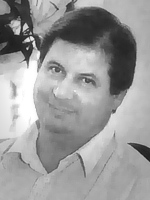 |
Oleg Ivanovich
Shapkin (born 1955) came to Fedoskino to join the
G.I. Larishev and P.S. Davydov classes. He has been working
in the Factory of Miniature Painting since 1974. Shapkin graduated
from the Department of Theory and History of Art, of the Institute
of Painting, Sculpture and Architecture in Leningrad. He is
currently residing and working in Fedoskino.
Oleg Shapldn is fond of using decorative effects in his lacquer
miniatures. His genre motifs display an extravaganza of spectacular
female robes shining with mother-of-pearl and gold. Instead
of striving to represent the lifestyle of a particular epoch,
the artist chooses to create compositions according to his
own perceptions. In Palm Sunday, mother and daughter are clad
in rich fur coats adorned with gold designs. They are returning
from church in early spring on a frosty and sunny day. The
girl in mittens carefully presses branches of the blessed
white willow against her breast, for in Russia the white willow
branches signify the festival of the Lord's Entry into Jerusalem. |
to the top
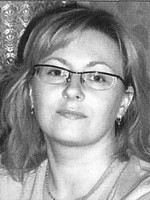 |
Margarita
Anatolievna Belova Was born in the Moscow suburban
area. Studied at Fedoskino School of Miniature Painting from
1985 to 1989. Teachers: D.V.Rogatov, BV.Gorodilin. Works at
Fedoskino Factory of Miniature Painting. Participant of shows.
Work themes: folklore, genre scenes, portraits. Lives and
works in Fedoskino. |
to the top
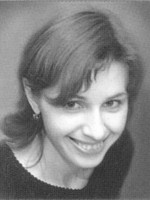 |
Svetlana
Alexandrovna Belovodova Was bom in 1975. From 1991
to 1996 - studied at Fedoskino Art Industrial School of Miniature
Painting. Since 1996 has been working at Fedoskino Factory
of Miniature Painting.
Shows:
1996 - «Young Talents - 96», Moscow, Polytechnical
Museum; 2001 - «Clear Spring - Fedoskino», Wards
of an old English court;
2003 - «Russian Lacquer Miniature Paintings: Sources
and Present Time» All-Russian Museum of Ornamental-Applied
and Folk Art;
2003 - «X-th All-Russian Show», Central House
of Artists;
2004 - «Fedoskino - Two Generations», State Duma
of the Russian Federation.
Works are in private collections in Russia, USA, and England.
|
to the top
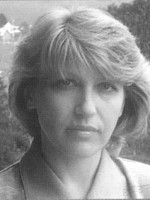 |
Natalya
Mikhailovna Khizhnyak Was born In 1964 in a small
town of Bronnitsy of the Moscow region. In 1980 entered Fedoskino
School of Miniature Painting. Teachers: V.N. Frolov and V.S.
Kulgavov. Since 1984 has been working at Fedoskino Factory
of Miniature Painting. Member of the Union of Artists. Exhibitions
:
1990 - First Universal Exhibition in Leningrad;
1993 - Dmitrov Kremlin; 1994 - Star City;
1996 - Embassy of Holland (Moscow). Exhibition «200
Years of Fedoskino»;
1997 - Mexico (Mexico);
1999 - Moscow Manege. Show «Moscow Regional Union of
Artists is 50»;
2000 - Show at the Central House of Artists;
2003 - Lipetsk. Exhibition of the Moscow Regional Union of
Artists
2004 - Paris (France).
|
to the top
 |
Vladislav
Sergheyevich Maslov Was born in 197) in a family
of artists. In 1986 entered Fedoskino School of Miniature
Painting. Teachers: V.N.Kulgavov, N.G. Marchukov, L.S. Pashinina,
V.N. Frolov. Since 1991 has been working at Fedoskino Factory
of Miniature Painting. Participant of shows. Works are in
private collections of Russia and abroad. |
to the top
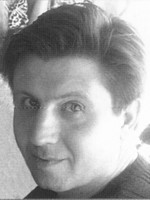 |
Yuri Borisovich
Mikhalev Was born on August 2, 1965 in the town of
Bogorodsk (former Noginsk). In 7980 entered Fedoskino School
of Miniature Painting. Techniques of Fedoskino painting were
taught by V.S.Ku/gavov, one of the best masters of the trade.
In 1984 finished the School. From 1987 till 2004 worked at
Fedoskino Factory of Miniature Painting. Participant of shows
since 1992. Main part of works is in private collections of
professionals and amateurs of miniature paintings. |
to the top
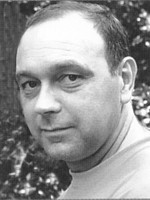 |
Vladimir
Sergheyevich Monashov Was born in the village of
Fedoskino, Mitischi district of the Moscow region on January
20, 1965. In 1980 entered Fedoskino School of Miniature Painting,
Fedoskino Department. In 1986 came to work at Fedoskino Factory
of Miniature Painting. Member of the Creative Union of Artists
and Moscow Regional Union of Artists. Participant of numerous
shows. Works are in private collections of Russia and abroad. |
to the top
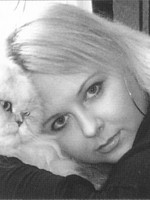 |
Natalya Grigoryevna
Orlova (Torbina) Was born in 1975 in the town of
Dmitrov, Moscow region. In 1996 finished Fedoskino School
of Miniature Painting. For 17 years has been working as an
artist at Fedoskino Factory. Made more than 200 creative works.
Participated in shows, works were published in catalogues.
Works are in private collections in Russia and the USA. |
to the top
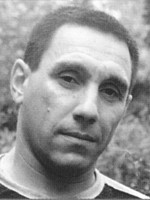 |
Mikhail Anatolievich
Papenov Was born in 1963 In the village of Fedoskino.
Is a hereditary artist of Fedoskino. After graduation from
the Art School works at Fedoskino Factory of Miniature Painting.
A favorite genre of Mikhail Papenov is landscape. Member of
the Union of Artists. |
to the top
 |
Serghei
Vyacheslavovich Parmenov Was born in 1964. In 1979
entered Fedoskino School of Miniature Painting. Teachers:
S.S. Chistov, N.M. Sytova. In 1986 came to work at Fedoskino
Factory of Miniature Painting. Permanent participant of shows,
in particular devoted to the anniversary of the Moscow Regional
Union of Artists. Works are in private collections of Russia
and abroad. |
to the top
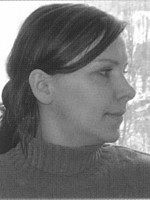 |
Irina Nickolaevna
Turbeneva Was born in 1968 in the village of Marfino,
Mitischi district of the Moscow region, in 1983 entered Fedoskino
School of Miniature Painting where began show activities,
which continued at Fedoskino Factory of Miniature Painting
that she joined in 1987. Participant of numerous regional,
zonal and republican shows. Has a number of awards for contribution
in the development of decorative art. Works are in museums
and private collections both in Russia and abroad. |
to the top
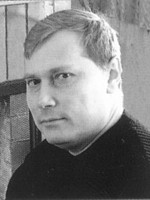 |
Alexey Yuryevich
Valyalin Was born on May 9, 1970 in a village of
Fedoskino, Mitischi district of the Moscow region. In 1985
entered Fedoskino School of Miniature Painting. Teachers:
V. Antonov, V. Frolov. Since 1993 has been working at Fedoskino
Factory of Miniature Painting. Participant of shows, works
are in private collections of Russia and abroad. |
to the top |
